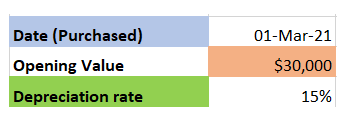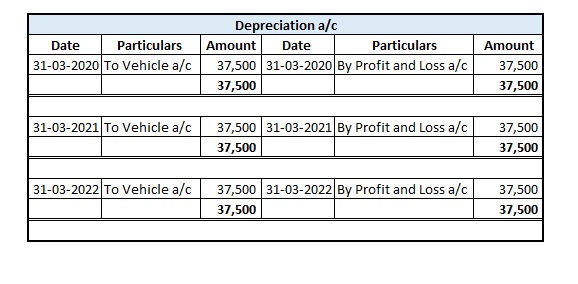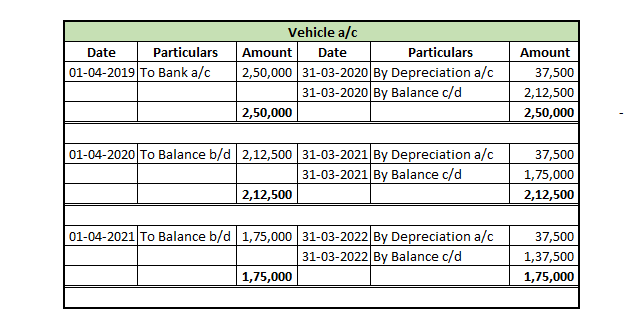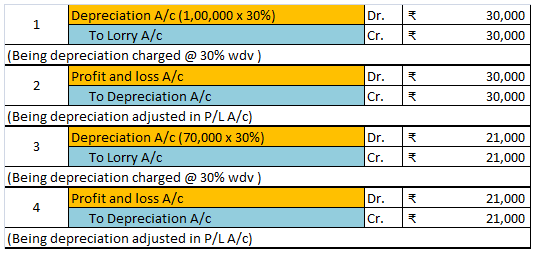Straight Line Depreciation Journal Entry Straight-line depreciation refers to the diminishing value of assets over the life of the asset. In other words, the cost of the asset spreads evenly over the useful life of the assets. The salvage value or Residual value of an asset means the estimated valueRead more
Straight Line Depreciation Journal Entry
Straight-line depreciation refers to the diminishing value of assets over the life of the asset. In other words, the cost of the asset spreads evenly over the useful life of the assets.
The salvage value or Residual value of an asset means the estimated value of the asset at the end of its useful life.
The depreciation can also be charged with another method like Written Down Value (WDV) Method.
Formula
Depreciation per annum = ( Cost of asset – Salvage Value) / Useful Life
The journal entry for the depreciation is:
|
JOURNAL ENTRIES |
||
| Depreciation on Asset A/C DR. | ||
| To Asset A/C | ||
| (Being depreciation charged on asset) |
Now let us understand this with an example, suppose XYZ Ltd. has an asset of value 90,000 with a useful life of 3 years. The company uses the straight-line method of depreciation to depreciate the asset in its book.
So, the depreciation per annum would be calculated as:-
= 90,000/3
= 30,000
In Year 1, the depreciation will be charged as 30,000 for this year. It will be debited to the depreciation account and credited to the asset account. Thus, the value of the asset at the end of year 1 will be 60,000 (90,000-30,000).
|
JOURNAL ENTRIES |
||||
| DR | CR | |||
| Depreciation on Asset A/C 30,000 | ||||
| To Asset A/C 30,000 | ||||
| (being depreciation charged on asset) |
In Year 2, the depreciation will be charged as 30,000. The entry would be the same as the previous year. The value of the asset at the end of year 2 will be 30,000 (60,000-30,000).
| JOURNAL ENTRIES | ||||
| DR | CR | |||
| Depreciation on Asset A/C 30,000 | ||||
| To Asset A/C 30,000 | ||||
| (being depreciation charged on asset) |
At last in Year 3, the depreciation will be charged 30,000. The entry would be the same. The value of the asset at the end of year 3 will be Nil (30,000- 30,000).
|
JOURNAL ENTRIES |
||||
| DR |
CR |
|||
| Depreciation on Asset A/C 30,000 | ||||
| To Asset A/C 30,000 | ||||
| (being depreciation charged on asset) |
The depreciation will be charged to the profit and loss account for the year as it is an expense for the company.
The entries will be posted into depreciation account as mentioned:
| DEPRECIATION A/C | |||||||
| Date | Particulars | Amount | Date | Particulars | Amount | ||
| Year 1 | To Asset A/C | 30,000 | By Profit and Loss A/C | 30,000 | |||
| 30,000 | 30,000 | ||||||
| Year 2 | To Asset A/C | 30,000 | By Profit and Loss A/C | 30,000 | |||
| 30,000 | 30,000 | ||||||
| Year 3 | To Asset A/C | 30,000 | By Profit and Loss A/C | 30,000 | |||
| 30,000 | 30,000 | ||||||
See less

















As per the Income-tax act, solar panels are categorized under the heading renewal energy devices. The rate of depreciation for these devices is mentioned below. As per the act, the rate of depreciation for solar panels is given as 40% as per the WDV method. Generally, these devices are treated as inRead more
As per the Income-tax act, solar panels are categorized under the heading renewal energy devices. The rate of depreciation for these devices is mentioned below.
As per the act, the rate of depreciation for solar panels is given as 40% as per the WDV method. Generally, these devices are treated as investments in fixed assets. Therefore they are treated accordingly like other fixed assets and are depreciated periodically in an organized and regular time period. The useful life of such solar devices is taken to be 5 years.
Giving you a small example of the depreciation on solar panels.
Solar panels were purchased by Agro Farm ltd. for installing them to be used for electricity generation. These panels were bought for Rs 2,00,000. Therefore depreciation to be charged as per income tax act over its useful life of 5 years is as follows:
Depreciation as per WDV = (Cost of an asset – salvage value)* rate of depreciation
Depreciation for 1st year = (2,00,000 – 0)* 40% = Rs 80,000
WDV at the end of 1st year = (2,00,000 – 80,000) = Rs 1,20,000
Depreciation for 2nd year = (1,20,000 – 0)* 40% = Rs 48,000
the same process will continue till the useful life of an asset.
The depreciation amount will be written off from the book value as shown below:
See less